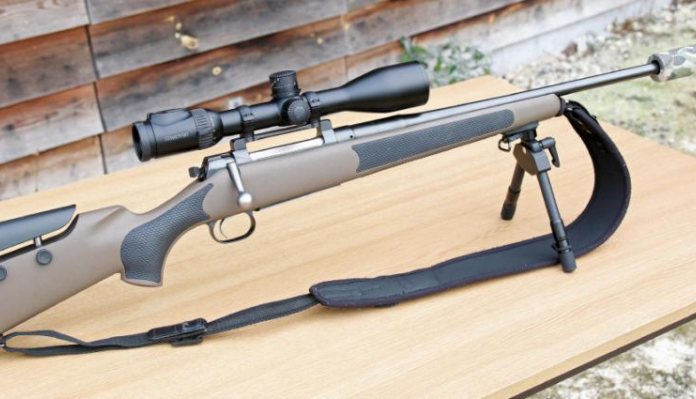Swarovski BTF
- By Pete Moore
-
2
 Comments
Comments
- Last updated: 27/04/2018

The concept of the ability to quickly add or remove a ballistic turret system to a telescopic sight is an intriguing one. It also flies in the face of accepted thinking, as if you want a scope with this facility, which will usually be a higher magnification variable, then that is what you buy, with no thought of ever not needing it. I have three varmint-type scopes, all used for longer range shooting, where pin point accuracy on small targets is required. But for general hunting needs something around a 3-12 x 56 with standard turrets is my ideal.
No stranger to Swarovski’s excellent Z6i and later Z8i scopes, the news that the latter came with standard turrets, but you could buy a quick detachable (QD) system for elevation or windage or both that would turn it into a more precision system was intriguing. Called BTF (Ballistic Turret Flex) it can be fitted to three models in the Z8i range; 1.7-13.3x42 P, 2-16x50 P and 2.3-18x56 P, the 1-8x24 does not offer this facility, nor does it really need it. Nor for my usage does my favourite model the 1.7-13.3 x 42, but the two higher spec models would seem well suited!
On test in part 1 (March issue) was the 2-16x50 P, which unsurprisingly proved to be a typical, high end Swarovski product. To this, they supplied a BTF set, which consisted of the QD turret body, a set of six range rings, and 1cm graduated elevation and windage sleeves. The QD body has a locking ring at the base with a rubber button on the top and a screw-on keeper plate, which as we shall see retains the rings and graduated sleeves. But first we need to zero!
For the test, I fitted the Z8i 2-16x50 P to my Mauser M03 in its 223 Rem mode. My pet handload is pushing a 69-grain Sierra, Tipped Match King (TMK) bullet at 2902 fps with 24.3-grains of Ramshot TAC. You have however, to take your zero distance into account, as that will affect the amount of clicks you have available for elevation, the further out it is the more you will have. Taking this 223 load as an example, at a maximum range of 500 yards, a 100-yard zero drops 59.85” and needs +33.25 clicks. A 180Z drops 53.74” and requires 30; after zeroing, the BTF had 35-clicks available!
Not a lot in it, but transfer that to a slower calibre and what’s left after zeroing could make a difference and dictate your maximum range! Taking it slower, a 6.5x55 Swedish, firing Winchester’s 140-grain soft tip factory load at 2460 fps drops 86.13” at 500 yards, with a correction required of 44-clicks. These are extreme distance to illustrate the theory, but I feel it’s fair to say that the single turn available with the BTF turret is more than enough to handle most calibres at maximum, sensible hunting ranges! The only caveat is how much adjustment you use when zeroing!
The lower section of the BTF drum has a graduated, rotary scale (1cms) with a white triangle indicating minimum elevation, below this is a fixed section with a white alignment dot, which locates at 6 o’clock. To fit, remove the turret cap and slide the BTF down, so that the slot on the inside locates with a pin on the turret thread, then push down until you hear a click and you’re engaged! Once fitted on a zeroed turret, the BTF also acts as a zero-stop, which is useful, as you cannot get lost in movement, just dial back until is stops and you’re on base zero!
Next, the individual range rings; you get six marked up 2, 3, 4 and 5 and two with white dots on, however, only four can fit at any one time. Unlike the 1cm sleeve, which you dial in a correction, these are set to specific, shooter-selected distances. It’s here that selecting a longer zero distance will pay benefits. For example, on my 223 load a 180Z shoots +/- an inch out to 200 yards and is 1.2” high at 100. From there, you can then figure out what the other settings should be using a ballistic calculator, for example; go 250, 300, 350 and 400m. Then note the drops, so allowing you to select a distance nearest the target then click up/down accordingly.
Now the BTF is connected to a turret, elevation would seem logical, but it can equally go on the windage, which unless you have two is a bit of a waste! However, the windage ring is split 35-0-35, which makes directional dialing easier. Easier, is the 4A-I reticle, which is graduated on the 3 to 9 O’clock axis, which allows you to aim off.
The final item is the locking ring at the base of the BTF, that will fix any setting you make. It has small lugs on it for manipulation as well as notation. When unlocked, they sit at 12 to 6 O’clock, rotating it clock-wise to 3 to 9 O’clock locks it. The BTF can be fitted or removed even when locked
In use, the BTF system worked effectively and of the two notations I preferred the 1cm elevation sleeve, as I found it easier, as with the range rings you must decide where you want them and if the target does not appear where you’ve selected you must dial up/down anyway. Most shooters will opt for elevation and not windage, but Swarovski should perhaps offer a twin turret option, where if you want, you can fit to both, without having to buy another complete system.
